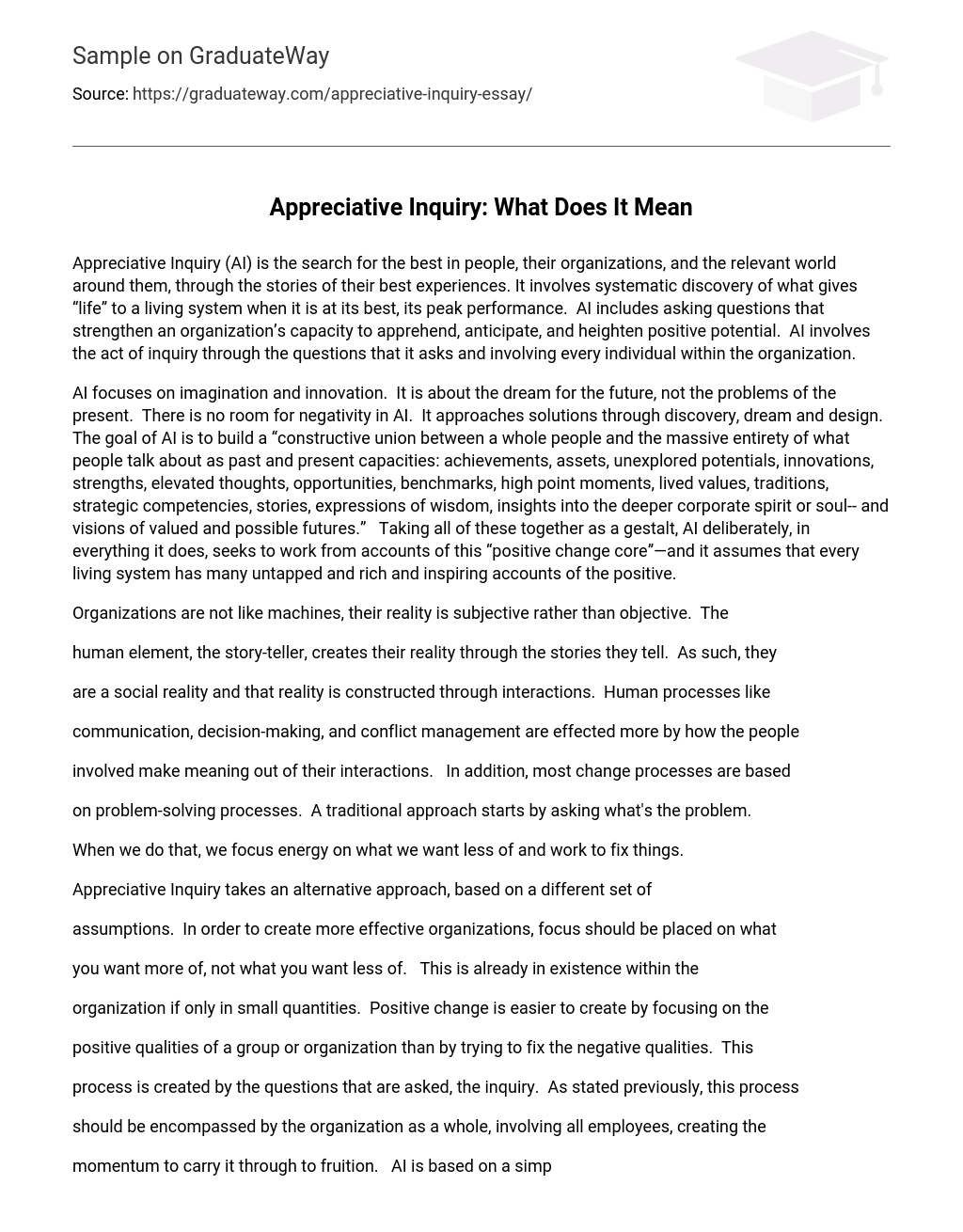Appreciative Inquiry (AI) is the search for the best in people, their organizations, and the relevant world around them, through the stories of their best experiences. It involves systematic discovery of what gives “life” to a living system when it is at its best, its peak performance. AI includes asking questions that strengthen an organization’s capacity to apprehend, anticipate, and heighten positive potential. AI involves the act of inquiry through the questions that it asks and involving every individual within the organization.
AI focuses on imagination and innovation. It is about the dream for the future, not the problems of the present. There is no room for negativity in AI. It approaches solutions through discovery, dream and design. The goal of AI is to build a “constructive union between a whole people and the massive entirety of what people talk about as past and present capacities: achievements, assets, unexplored potentials, innovations, strengths, elevated thoughts, opportunities, benchmarks, high point moments, lived values, traditions, strategic competencies, stories, expressions of wisdom, insights into the deeper corporate spirit or soul and visions of valued and possible futures.” Taking all of these together as a gestalt, AI deliberately, in everything it does, seeks to work from accounts of this “positive change core”—and it assumes that every living system has many untapped and rich and inspiring accounts of the positive.
Organizations are not like machines, their reality is subjective rather than objective. The human element, the story-teller, creates their reality through the stories they tell. As such, they are a social reality and that reality is constructed through interactions. Human processes like communication, decision-making, and conflict management are effected more by how the people involved make meaning out of their interactions.
In addition, most change processes are based on problem-solving processes. A traditional approach starts by asking what’s the problem. When we do that, we focus energy on what we want less of and work to fix things. Appreciative Inquiry takes an alternative approach, based on a different set of assumptions. In order to create more effective organizations, focus should be placed on what you want more of, not what you want less of.
This is already in existence within the organization if only in small quantities. Positive change is easier to create by focusing on the positive qualities of a group or organization than by trying to fix the negative qualities. This process is created by the questions that are asked, the inquiry. As stated previously, this process should be encompassed by the organization as a whole, involving all employees, creating the momentum to carry it through to fruition.
AI is based on a simple premise: that organizations grow in the direction of what they repeatedly ask questions about and focus their attention on. AI does not focus on changing people. Instead, it involves people to engage in building the kinds of organizations they want to live in.
There are four key stages involved in the process of AI:
- Discovery—mobilizing a whole system inquiry into the positive change core;
- Dream—creating a clear results-oriented vision in relation to discovered potential and in relation to questions of higher purpose.
- Design—creating possibility propositions of the ideal organization, an organization design which people feel is capable of magnifying or eclipsing the positive core and realizing the articulated new dream; and
- Destiny—strengthening the affirmative capability of the whole system enabling it to build hope and momentum around a deep purpose and creating processes for learning, adjustment, and improvisation.
The core task of the discovery phase is to discover and disclose positive capacity, at least until an organization’s understanding of this surplus is exhausted. AI provides a way to ignite this “spirit of inquiry” on an organization-wide basis. What distinguishes AI, especially in this phase of work, is that every question is positive. Knowing and changing are a simultaneous moment. The process of discovery becomes the process of creating. As people throughout a system connect in serious study into qualities, examples, and analysis of the positive core –each appreciating and everyone being appreciated– hope grows and community expands.
During the dream phase, the interview stories and insights are used to construct a new reality. People are brought together to listen carefully to the innovations and moments of organizational life, sometimes in storytelling modes, sometimes in interpretive and analytic modes, creating a place where the future begins to be formed and visible patterns interwoven into the texture of the actual. The amplified interaction among innovators and innovations makes something important happen: very rapidly we start seeing outlines of the “New World.”
This can be turned into a special commemorative report celebrating the successes and exceptional moment in the life of the organization. Others have created a thematic analysis—careful to document rich stories and not succumb to “narrative thin” one line quotes. In all cases the data onto the positive change core serves as an essential resource for the visioning stages of the appreciative inquiry 4- D model.





